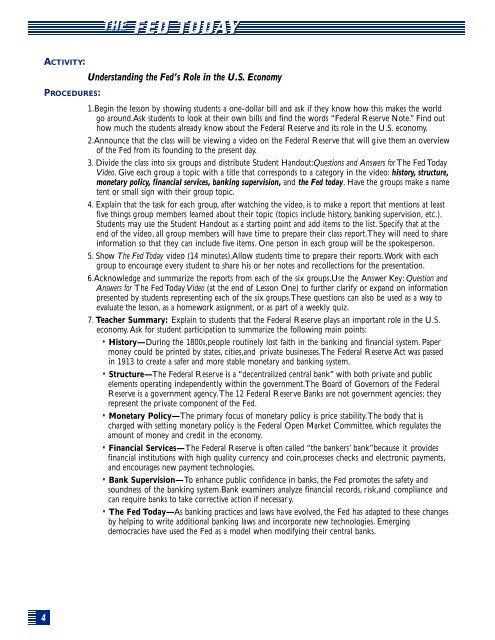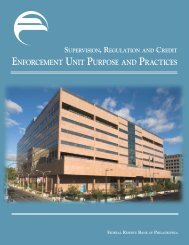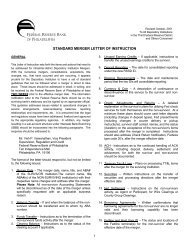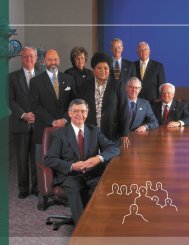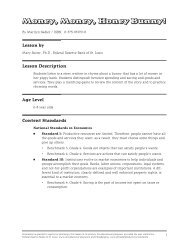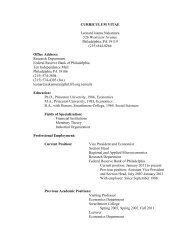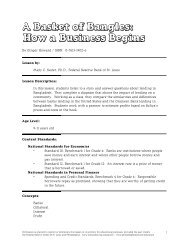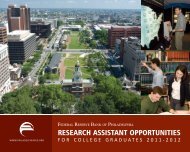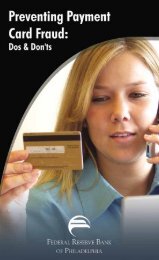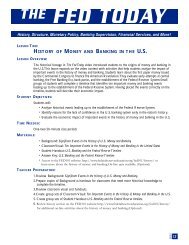The Fed Today: Lesson One - Federal Reserve Bank of Philadelphia
The Fed Today: Lesson One - Federal Reserve Bank of Philadelphia
The Fed Today: Lesson One - Federal Reserve Bank of Philadelphia
Create successful ePaper yourself
Turn your PDF publications into a flip-book with our unique Google optimized e-Paper software.
T H E F E D T O DAY<br />
ACTIVITY:<br />
PROCEDURES:<br />
Understanding the <strong>Fed</strong>’s Role in the U.S. Economy<br />
1.Begin the lesson by showing students a one-dollar bill and ask if they know how this makes the world<br />
go around.Ask students to look at their own bills and find the words “<strong>Fed</strong>eral <strong>Reserve</strong> Note.” Find out<br />
how much the students already know about the <strong>Fed</strong>eral <strong>Reserve</strong> and its role in the U.S. economy.<br />
2.Announce that the class will be viewing a video on the <strong>Fed</strong>eral <strong>Reserve</strong> that will give them an overview<br />
<strong>of</strong> the <strong>Fed</strong> from its founding to the present day.<br />
3. Divide the class into six groups and distribute Student Handout:Questions and Answers for <strong>The</strong> <strong>Fed</strong> <strong>Today</strong><br />
Video. Give each group a topic with a title that corresponds to a category in the video: history, structure,<br />
monetary policy, financial services, banking supervision, and the <strong>Fed</strong> today. Have the groups make a name<br />
tent or small sign with their group topic.<br />
4. Explain that the task for each group, after watching the video, is to make a report that mentions at least<br />
five things group members learned about their topic (topics include history, banking supervision, etc.).<br />
Students may use the Student Handout as a starting point and add items to the list. Specify that at the<br />
end <strong>of</strong> the video, all group members will have time to prepare their class report.<strong>The</strong>y will need to share<br />
information so that they can include five items. <strong>One</strong> person in each group will be the spokesperson.<br />
5. Show <strong>The</strong> <strong>Fed</strong> <strong>Today</strong> video (14 minutes).Allow students time to prepare their reports.Work with each<br />
group to encourage every student to share his or her notes and recollections for the presentation.<br />
6.Acknowledge and summarize the reports from each <strong>of</strong> the six groups.Use the Answer Key: Question and<br />
Answers for <strong>The</strong> <strong>Fed</strong> <strong>Today</strong> Video (at the end <strong>of</strong> <strong>Lesson</strong> <strong>One</strong>) to further clarify or expand on information<br />
presented by students representing each <strong>of</strong> the six groups.<strong>The</strong>se questions can also be used as a way to<br />
evaluate the lesson, as a homework assignment, or as part <strong>of</strong> a weekly quiz.<br />
7. Teacher Summary: Explain to students that the <strong>Fed</strong>eral <strong>Reserve</strong> plays an important role in the U.S.<br />
economy.Ask for student participation to summarize the following main points:<br />
• History—During the 1800s,people routinely lost faith in the banking and financial system. Paper<br />
money could be printed by states, cities,and private businesses.<strong>The</strong> <strong>Fed</strong>eral <strong>Reserve</strong> Act was passed<br />
in 1913 to create a safer and more stable monetary and banking system.<br />
• Structure—<strong>The</strong> <strong>Fed</strong>eral <strong>Reserve</strong> is a “decentralized central bank” with both private and public<br />
elements operating independently within the government.<strong>The</strong> Board <strong>of</strong> Governors <strong>of</strong> the <strong>Fed</strong>eral<br />
<strong>Reserve</strong> is a government agency.<strong>The</strong> 12 <strong>Fed</strong>eral <strong>Reserve</strong> <strong>Bank</strong>s are not government agencies; they<br />
represent the private component <strong>of</strong> the <strong>Fed</strong>.<br />
• Monetary Policy—<strong>The</strong> primary focus <strong>of</strong> monetary policy is price stability.<strong>The</strong> body that is<br />
charged with setting monetary policy is the <strong>Fed</strong>eral Open Market Committee, which regulates the<br />
amount <strong>of</strong> money and credit in the economy.<br />
• Financial Services—<strong>The</strong> <strong>Fed</strong>eral <strong>Reserve</strong> is <strong>of</strong>ten called “the bankers’ bank”because it provides<br />
financial institutions with high quality currency and coin,processes checks and electronic payments,<br />
and encourages new payment technologies.<br />
• <strong>Bank</strong> Supervision—To enhance public confidence in banks, the <strong>Fed</strong> promotes the safety and<br />
soundness <strong>of</strong> the banking system.<strong>Bank</strong> examiners analyze financial records, risk,and compliance and<br />
can require banks to take corrective action if necessar y.<br />
• <strong>The</strong> <strong>Fed</strong> <strong>Today</strong>—As banking practices and laws have evolved, the <strong>Fed</strong> has adapted to these changes<br />
by helping to write additional banking laws and incorporate new technologies. Emerging<br />
democracies have used the <strong>Fed</strong> as a model when modifying their central banks.<br />
4


